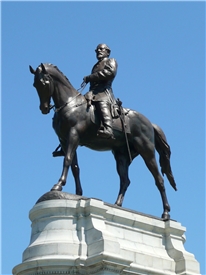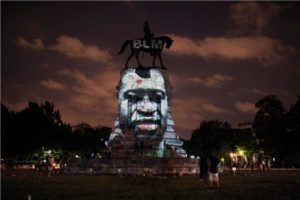Plague Journal, One Hundred & Fifty Six
How many years
since the War of Southern Rebellion ended?
 For many of those years a statue of Robert E. Lee mounted on his horse Traveler has occupied a prominent place on Monument Avenue in Richmond Virginia. Lee was commander in chief of the pro-slavery forces (human trafficking) that fought for four long years to sever the slave owning states from the Union. Lee was a slave owner. He admitted that slavery was wrong. Nevertheless Lee offered his military skills to the Army of Northern Virginia.
For many of those years a statue of Robert E. Lee mounted on his horse Traveler has occupied a prominent place on Monument Avenue in Richmond Virginia. Lee was commander in chief of the pro-slavery forces (human trafficking) that fought for four long years to sever the slave owning states from the Union. Lee was a slave owner. He admitted that slavery was wrong. Nevertheless Lee offered his military skills to the Army of Northern Virginia.
It can be argued that the war lasted longer than it might otherwise have because against long odds, the men were willing to fight on for Lee. The South was effectively defeated after the failure at Gettysburg, and the loss of Vicksburg in July of 1863.
Lee was made a mythic figure in the years following the war, a part of the “lost cause” mythology. It pays to take note of how powerful, how effective story telling can be. As the wily commander of Southern forces Lee was indirectly responsible for the three quarters of a million people on both sides who lost their lives in the  maelstrom of war. I doubt the number includes those who died due to disease, exposure and starvation.
maelstrom of war. I doubt the number includes those who died due to disease, exposure and starvation.
My great uncle, Thomas Mc Lamb served in the Army of Northern Virginia.
Yesterday the statue of Lee was removed from its pedestal on Monument Avenue. It is late — in the arc of the story of this nation.
People of color, Black citizens continue to have their lives taken, victims of contemporary bigotry embedded in the DNA of this country. George Floyd is only one case in point.
The war is not over, not really.